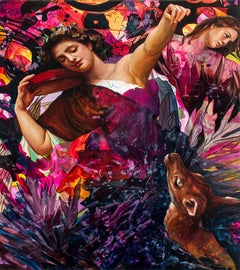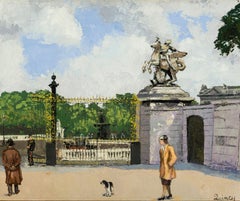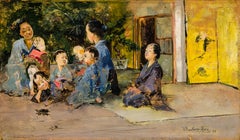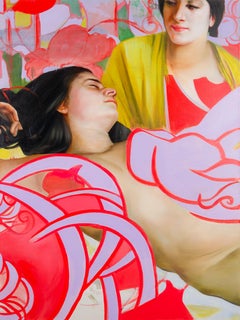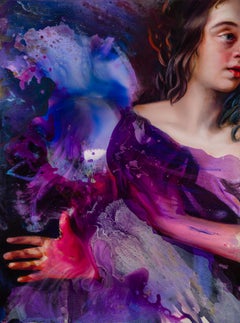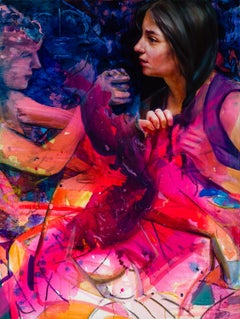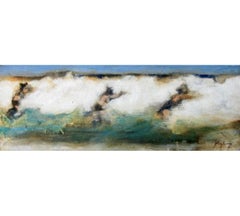Hirschl & Adler Figurative Paintings
to
3
6
2
5
6
Overall Width
to
Overall Height
to
5
2
15
15
1
16
6
22
20
8
7
4
3
3
3
3
2
2
1
1
1
1
1
1
1
1
1
22
21
19
11
8
15
2
1
1
1
1
22
The Circle is Cast, We Are Between the Worlds
By Angela Fraleigh
Located in New York, NY
In Angela Fraleigh’s dynamic paintings, female subjects culled from art history become active protagonists in newly imagined spaces. In their original contexts, these figures were largely painted as docile objects for the male gaze...
Category
2010s Figurative Paintings
Materials
Oil, Acrylic
Jardin des Tuileries, Paris
By Edmund Quincy
Located in New York, NY
Signed (lower right): Quincy
Category
20th Century American Realist Figurative Paintings
Materials
Canvas, Oil
Japanese Children with Tortoise
By Harry Humphrey Moore
Located in New York, NY
Harry Humphrey Moore led a cosmopolitan lifestyle, dividing his time between Europe, New York City, and California. This globe-trotting painter was also active in Morocco, and most importantly, he was among the first generation of American artists to live and work in Japan, where he depicted temples, tombs, gardens, merchants, children, and Geisha girls. Praised by fellow painters such as Thomas Eakins, John Singer Sargent, and Jean-Léon Gérôme, Moore’s fame was attributed to his exotic subject matter, as well as to the “brilliant coloring, delicate brush work [sic] and the always present depth of feeling” that characterized his work (Eugene A. Hajdel, Harry H. Moore, American 19th Century: Collection of Information on Harry Humphrey Moore, 19th Century Artist, Based on His Scrap Book and Other Data [Jersey City, New Jersey: privately published, 1950], p. 8).
Born in New York City, Moore was the son of Captain George Humphrey, an affluent shipbuilder, and a descendant of the English painter, Ozias Humphrey (1742–1810). He became deaf at age three, and later went to special schools where he learned lip-reading and sign language. After developing an interest in art as a young boy, Moore studied painting with the portraitist Samuel Waugh in Philadelphia, where he met and became friendly with Eakins. He also received instruction from the painter Louis Bail in New Haven, Connecticut. In 1864, Moore attended classes at the Mark Hopkins Institute in San Francisco, and until 1907, he would visit the “City by the Bay” regularly.
In 1865, Moore went to Europe, spending time in Munich before traveling to Paris, where, in October 1866, he resumed his formal training in Gérôme’s atelier, drawing inspiration from his teacher’s emphasis on authentic detail and his taste for picturesque genre subjects. There, Moore worked alongside Eakins, who had mastered sign language in order to communicate with his friend. In March 1867, Moore enrolled at the prestigious École des Beaux-Arts, honing his drawing skills under the tutelage of Adolphe...
Category
Late 19th Century Figurative Paintings
Materials
Oil, Wood Panel
The Stars Rise, the Moon Bends Her Arc
By Angela Fraleigh
Located in New York, NY
Signed and dated (on verso): Angela Fraleigh 2021
Category
2010s Contemporary Figurative Paintings
Materials
Linen, Oil
Stars Splinter, Pointed and Wild
By Angela Fraleigh
Located in New York, NY
Unsigned
Category
2010s Contemporary Portrait Paintings
Materials
Linen, Oil
In an Absent Dream
By Angela Fraleigh
Located in New York, NY
Unsigned
Category
2010s Contemporary Portrait Paintings
Materials
Canvas, Charcoal, Oil
A Word For What Binds
By Angela Fraleigh
Located in New York, NY
Unsigned
Category
2010s Contemporary Portrait Paintings
Materials
Canvas, Charcoal, Oil
Splinters of a Secret Sky - Splinters
By Angela Fraleigh
Located in New York, NY
Signed (on verso): AF/2021
Category
2010s Contemporary Portrait Paintings
Materials
Canvas, Acrylic Polymer, Oil, Acrylic
Japanese Girl Promenading
By Harry Humphrey Moore
Located in New York, NY
Harry Humphrey Moore led a cosmopolitan lifestyle, dividing his time between Europe, New York City, and California. This globe-trotting painter was also active in Morocco, and most importantly, he was among the first generation of American artists to live and work in Japan, where he depicted temples, tombs, gardens, merchants, children, and Geisha girls. Praised by fellow painters such as Thomas Eakins, John Singer Sargent, and Jean-Léon Gérôme, Moore’s fame was attributed to his exotic subject matter, as well as to the “brilliant coloring, delicate brush work [sic] and the always present depth of feeling” that characterized his work (Eugene A. Hajdel, Harry H. Moore, American 19th Century: Collection of Information on Harry Humphrey Moore, 19th Century Artist, Based on His Scrap Book and Other Data [Jersey City, New Jersey: privately published, 1950], p. 8).
Born in New York City, Moore was the son of Captain George Humphrey, an affluent shipbuilder, and a descendant of the English painter, Ozias Humphrey (1742–1810). He became deaf at age three, and later went to special schools where he learned lip-reading and sign language. After developing an interest in art as a young boy, Moore studied painting with the portraitist Samuel Waugh in Philadelphia, where he met and became friendly with Eakins. He also received instruction from the painter Louis Bail in New Haven, Connecticut. In 1864, Moore attended classes at the Mark Hopkins Institute in San Francisco, and until 1907, he would visit the “City by the Bay” regularly.
In 1865, Moore went to Europe, spending time in Munich before traveling to Paris, where, in October 1866, he resumed his formal training in Gérôme’s atelier, drawing inspiration from his teacher’s emphasis on authentic detail and his taste for picturesque genre subjects. There, Moore worked alongside Eakins, who had mastered sign language in order to communicate with his friend. In March 1867, Moore enrolled at the prestigious École des Beaux-Arts, honing his drawing skills under the tutelage of Adolphe Yvon, among other leading French painters.
In December 1869, Moore traveled around Spain with Eakins and the Philadelphia engraver, William Sartain. In 1870, he went to Madrid, where he met the Spanish painters Mariano Fortuny and Martin Rico y Ortega. When Eakins and Sartain returned to Paris, Moore remained in Spain, painting depictions of Moorish life in cities such as Segovia and Granada and fraternizing with upper-crust society. In 1872, he married Isabella de Cistue, the well-connected daughter of Colonel Cistue of Saragossa, who was related to the Queen of Spain. For the next two-and-a-half years, the couple lived in Morocco, where Moore painted portraits, interiors, and streetscapes, often accompanied by an armed guard (courtesy of the Grand Sharif) when painting outdoors. (For this aspect of Moore’s oeuvre, see Gerald M. Ackerman, American Orientalists [Courbevoie, France: ACR Édition, 1994], pp. 135–39.) In 1873, he went to Rome, spending two years studying with Fortuny, whose lively technique, bright palette, and penchant for small-format genre scenes made a lasting impression on him. By this point in his career, Moore had emerged as a “rapid workman” who could “finish a picture of given size and containing a given subject quicker than most painters whose style is more simple and less exacting” (New York Times, as quoted in Hajdel, p. 23).
In 1874, Moore settled in New York City, maintaining a studio on East 14th Street, where he would remain until 1880. During these years, he participated intermittently in the annuals of the National Academy of Design in New York and the Pennsylvania Academy of the Fine Arts in Philadelphia, exhibiting Moorish subjects and views of Spain. A well-known figure in Bay Area art circles, Moore had a one-man show at the Snow & May Gallery in San Francisco in 1877, and a solo exhibition at the Bohemian Club, also in San Francisco, in 1880. Indeed, Moore fraternized with many members of the city’s cultural elite, including Katherine Birdsall Johnson (1834–1893), a philanthropist and art collector who owned The Captive (current location unknown), one of his Orientalist subjects. (Johnson’s ownership of The Captive was reported in L. K., “A Popular Paris Artist,” New York Times, July 23, 1893.) According to one contemporary account, Johnson invited Moore and his wife to accompany her on a trip to Japan in 1880 and they readily accepted. (For Johnson’s connection to Moore’s visit to Japan, see Emma Willard and Her Pupils; or, Fifty Years of Troy Female Seminary [New York: Mrs. Russell Sage, 1898]. Johnson’s bond with the Moores was obviously strong, evidenced by the fact that she left them $25,000.00 in her will, which was published in the San Francisco Call on December 10, 1893.) That Moore would be receptive to making the arduous voyage across the Pacific is understandable in view of his penchant for foreign motifs. Having opened its doors to trade with the West in 1854, and in the wake of Japan’s presence at the Philadelphia Centennial Exposition of 1876, American artists were becoming increasingly fascinated by what one commentator referred to as that “ideal dreamland of the poet” (L. K., “A Popular Paris Artist”).
Moore, who was in Japan during 1880–81, became one of the first American artists to travel to the “land of the rising sun,” preceded only by the illustrator, William Heime, who went there in 1851 in conjunction with the Japanese expedition of Commodore Matthew C. Perry; Edward Kern, a topographical artist and explorer who mapped the Japanese coast in 1855; and the Boston landscapist, Winckleworth Allan Gay, a resident of Japan from 1877 to 1880. More specifically, as William H. Gerdts has pointed out, Moore was the “first American painter to seriously address the appearance and mores of the Japanese people” (William H. Gerdts, American Artists in Japan, 1859–1925, exhib. cat. [New York: Hollis Taggart Galleries, 1996], p. 5).
During his sojourn in Japan, Moore spent time in Tokyo, Yokohama, Kyoto, Nikko, and Osaka, carefully observing the local citizenry, their manners and mode of dress, and the country’s distinctive architecture. Working on easily portable panels, he created about sixty scenes of daily life, among them this sparkling portrayal of a young woman dressed in a traditional kimono and carrying a baby on her back, a paper parasol...
Category
Late 19th Century Figurative Paintings
Materials
Oil, Wood Panel
A late frost drifted back
By Angela Fraleigh
Located in New York, NY
Signed on back
Category
2010s Contemporary Figurative Paintings
Materials
Linen, Oil
Our story was a ghostly one
By Angela Fraleigh
Located in New York, NY
Signed on verso
Category
2010s Contemporary Figurative Paintings
Materials
Linen, Oil
Rooted in Constellations
By Angela Fraleigh
Located in New York, NY
Signed and dated (on verso): Angela Fraleigh 2021
Category
2010s Contemporary Figurative Paintings
Materials
Linen, Oil
Shaking to Sound the Silent Skies
By Angela Fraleigh
Located in New York, NY
Signed and dated (on verso): Angela Fraleigh 2021
Category
2010s Contemporary Figurative Paintings
Materials
Linen, Oil
Wait For Me There
By Angela Fraleigh
Located in New York, NY
Signed and dated (on verso): Angela Fraleigh 2021
Category
2010s Contemporary Figurative Paintings
Materials
Canvas, Oil, Panel
Tumbling into Light
By Angela Fraleigh
Located in New York, NY
Signed and dated (on verso): Angela Fraleigh 2021
Category
2010s Contemporary Figurative Paintings
Materials
Canvas, Oil, Panel
Silent Sparks
By Angela Fraleigh
Located in New York, NY
Signed and dated (on verso): Angela Fraleigh 2021
Category
2010s Contemporary Figurative Paintings
Materials
Canvas, Oil, Panel
From Sunset to Sunrise
By Angela Fraleigh
Located in New York, NY
Signed and dated (on verso): Angela Fraleigh 2021
Category
2010s Contemporary Figurative Paintings
Materials
Linen, Oil
A Pang of Vivid Light
By Angela Fraleigh
Located in New York, NY
Signed and dated (on verso): "Angela Fraleigh 2021"
Category
2010s Contemporary Figurative Paintings
Materials
Linen, Oil
One Afternoon in Tuscany
By Alan Feltus
Located in New York, NY
A contemporary figurative painter whose art is rooted in both the past and the present, Alan Feltus specializes in enigmatic depictions of women. Notable for their purity and simplic...
Category
20th Century Contemporary Figurative Paintings
Materials
Canvas, Alkyd
The Japanese Corner
By Elliott Daingerfield
Located in New York, NY
A child of the American South, Elliott Daingerfield was born in Harper’s Ferry, Virginia, and raised in Fayetteville, North Carolina, where his father, C...
Category
19th Century American Impressionist Interior Paintings
Materials
Canvas, Oil
The Race
By William John Hennessy
Located in New York, NY
William John Hennessy was born in Ireland. He came to America in 1849 with his mother and brother a year after his father had fled their homeland after taking part in the unsuccessful Young Ireland Party uprising. The Hennessys settled in New York, and when young William came of age, he decided upon a career as an artist. At the age of fifteen, he enrolled at the National Academy of Design, where he learned to draw from the antique, and the following year he was granted admission to the Academy’s life-drawing class.
Hennessy first exhibited at the National Academy in 1857, starting a continuous run of appearances in their annuals that lasted until 1870, when he expatriated himself to Europe. During his time in America, Hennessy was principally known as a genre painter and prolific illustrator for such publications as Harper’s Weekly and a number of books, including illustrated works of William Cullen Bryant...
Category
19th Century American Realist Figurative Paintings
Materials
Canvas, Oil
Peek-a-Boo
By Seymour Joseph Guy
Located in New York, NY
In the latter half of the nineteenth century and into the first decade of the twentieth, New York City art aficionados could count on finding recent work of Seymour Joseph Guy hanging on the walls of the city’s major galleries. Primarily a genre artist, but also a portraitist, between 1859 and 1908 Guy showed more than seventy works at the National Academy of Design. From 1871 to 1903 he contributed over seventy times to exhibitions at the Century Club. From 1864 to 1887, he sent about forty pictures to the Brooklyn Art Association. A good number of these works were already privately owned; they served as advertisements for other pictures that were available for sale. Some pictures were shown multiple times in the same or different venues. Guy was as easy to find as his canvases were omnipresent. Though he lived at first in Brooklyn with his family and then in New Jersey, from 1863 to his death in 1910 he maintained a studio at the Artist’s Studio Building at 55 West 10th Street, a location that was, for much of that period, the center of the New York City art world.
Guy’s path to a successful career as an artist was by no means smooth or even likely. Born in Greenwich, England, he was orphaned at the age of nine. His early interest in art was discouraged by his legal guardian, who wanted a more settled trade for the young man. Only after the guardian also died was Guy free to pursue his intention of becoming an artist. The details of Guy’s early training in art are unclear. His first teacher is believed to have been Thomas Buttersworth...
Category
19th Century American Realist Figurative Paintings
Materials
Canvas, Oil
$110,000
Related Items
"Mt. Evans and Bierstadt, Colorado" Oil Painting
Located in Denver, CO
David Shingler's (NC based) "Mt. Evans and Bierstadt, Colorado" is an oil painting that depicts a green grassy plain dotted with Pine trees leading to the snow capped mountains in th...
Category
2010s American Impressionist Figurative Paintings
Materials
Oil, Wood Panel
Surf (Trio)
By David Konigsberg
Located in Edgartown, MA
David Konigsberg was born in Warren PA and lives and works in Brooklyn NY. His rural and urban experience play out in a love for both landscape and conceptual narrative, genres he of...
Category
21st Century and Contemporary Figurative Paintings
Materials
Oil, Wood Panel
Girl with Braided Hair, Raphael Soyer
By Raphael Soyer
Located in Fairfield, CT
Artist: Raphael Soyer (1899-1987)
Title: Girl with Braided Hair
Year: Circa 1987
Medium: Oil on canvas
Size: 12 x 9 inches; framed size, 19 x 16 inches
Condition: Excellent
Inscripti...
Category
1980s American Realist Figurative Paintings
Materials
Canvas, Oil
$8,400 Sale Price
20% Off
H 12 in W 9 in
View from Visby, Gotland, c. 1883
Located in Stockholm, SE
This painting by Elisabeth Keyser beautifully captures a scenic view from the northern city wall of Visby, near Lübeckerbräschen. The landscape showcases a stretch of coastline leadi...
Category
1890s Impressionist Landscape Paintings
Materials
Oil, Wood Panel
$4,062 Sale Price
20% Off
H 7.88 in W 12.01 in
Midday nap- 21st century painting of a girl in a red dress on a blue sofa
By Ksenya Istomina
Located in Nuenen, Noord Brabant
Ksenya Istomina
'Midday Nap'
60 x 80 cm ( Frame is included in price, size framed in a black frame form the pictures is:
Oil on linen, framed
Painted after life, the artist always ...
Category
2010s Contemporary Figurative Paintings
Materials
Linen, Oil
$10,136
H 23.63 in W 31.5 in D 1.97 in
"Summer Day at the Beach" Oil Painting Scene with Figures, Umbrellas & Boats
By Niek van der Plas
Located in New York, NY
This captivating summer day beach scene is a remarkable display of Van der Plas's true passion for outdoor genre paintings. A wonderfully rich beach scene executed in the 21st Centur...
Category
21st Century and Contemporary Post-Impressionist Figurative Paintings
Materials
Oil, Wood Panel
$4,000
H 14.25 in W 16.25 in D 1.5 in
They after Batoni and Hodges
By Derrick Guild
Located in London, GB
Dimensions variable: medium oval 7.5cm x 9.5cm; large oval 9cm x 11cm.
Derrick Guild is a Scottish artist whose paintings fragment Old Master works to explore the social fabric bene...
Category
2010s Contemporary Portrait Paintings
Materials
Linen, Oil
"Old Shoemaker" Ashcan 20th Century Modernism 1924 California WPA Realism Worker
By Otis Oldfield
Located in New York, NY
"Old Shoemaker" Ashcan 20th Century Modernism 1924 California WPA Realism Worker. Signed “Otis Oldfield” lower left. 14 x 12 inches.
Exhibited: Galerie des Beaux Arts, San Francisco, CA, 1925
Provenance: Estate of the Artist
Born in Sacramento, CA on July 3, 1890, Otis Oldfield left high school at age 16 to work in a local print shop. In 1909 he arrived in San Francisco and enrolled at the Best Art School. After working for two years as a bellhop at the Argonaut Hotel and as a hat check boy at the Cliff House, he had saved enough money for further studies in Paris. In 1911 he sailed for France and enrolled at Académie Julian. Caught up in the activities of wartime Paris, he was an apprentice for a book...
Category
1920s American Realist Figurative Paintings
Materials
Canvas, Oil
Large Horse Oil Painting. Contemporary Equestrian Oil Painting 220 x 180 cm
By Rubins J. Spaans
Located in ALP, ES
This large figurative oil painting is a reinterpretation of two paintings by John Vanderbank, A young gentleman riding a schooled horse, 1729 / Man on horseback, 1728. A unique oil p...
Category
2010s Contemporary Animal Paintings
Materials
Canvas, Charcoal, Oil Crayon, Raw Linen, Oil, Spray Paint, Acrylic, Pencil
$2,250 Sale Price
70% Off
H 86.62 in W 70.87 in D 1.46 in
'Sketching Wisconsin' original oil painting, Signed
By John Steuart Curry
Located in Milwaukee, WI
John Steuart Curry
"Sketching Wisconsin," 1946
oil on canvas
31.13 x 28 inches, canvas
39.75 x 36.75 x 2.5 inches, frame
Signed and dated lower right
Overall excellent condition
Presented in a 24-karat gold leaf hand-carved wood frame
John Steuart Curry (1897-1946) was an American regionalist painter active during the Great Depression and into World War II. He was born in Kansas on his family’s farm but went on to study art in Chicago, Paris and New York as young man. In Paris, he was exposed to the work of masters such as Peter Paul Rubens, Eugène Delacroix and Jacques-Louis David. As he matured, his work showed the influence of these masters, especially in his compositional decisions. Like the two other Midwestern regionalist artists that are most often grouped with him, Grant Wood (American, 1891-1942) and Thomas Hart Benton (American, 1889-1975), Curry was interested in representational works containing distinctly American subject matter. This was contrary to the popular art at the time, which was moving closer and closer to abstraction and individual expression.
Sketching Wisconsin is an oil painting completed in 1946, the last year of John Steuart Curry’s life, during which time he was the artist-in-residence at the University of Wisconsin in Madison. The painting is significant in Curry’s body of work both as a very revealing self-portrait, and as a landscape that clearly and sensitively depicts the scenery of southern Wisconsin near Madison. It is also a portrait of the artist’s second wife, Kathleen Gould Curry, and is unique in that it contains a ‘picture within a picture,’ a compositional element that many early painting masters used to draw the eye of the viewer. This particular artwork adds a new twist to this theme: Curry’s wife is creating essentially the same painting the viewer is looking at when viewing Sketching Wisconsin.
The triangular composition of the figures in the foreground immediately brings focus to a younger Curry, whose head penetrates the horizon line and whose gaze looks out towards the viewer. The eye then moves down to Mrs. Curry, who, seated on a folding stool and with her hand raised to paint the canvas on the easel before her, anchors the triangular composition. The shape is repeated in the legs of the stool and the easel. Behind the two figures, stripes of furrowed fields fall away gently down the hillside to a farmstead and small lake below. Beyond the lake, patches of field and forest rise and fall into the distance, and eventually give way to blue hills.
Here, Curry has subverted the traditional artist’s self-portrait by portraying himself as a farmer first and an artist second. He rejects what he sees as an elitist art world of the East Coast and Europe. In this self-portrait he depicts himself without any pretense or the instruments of his profession and with a red tractor standing in the field behind him as if he was taking a break from the field work. Here, Curry’s wife symbolizes John Steuart Curry’s identity as an artist. Compared with a self-portrait of the artist completed a decade earlier, this work shows a marked departure from how the artist previously presented and viewed himself. In the earlier portrait, Curry depicted himself in the studio with brushes in hand, and with some of his more recognizable and successful canvases behind him. But in Sketching Wisconsin, Curry has taken himself out of the studio and into the field, indicating a shift in the artist’s self-conception.
Sketching Wisconsin’s rural subject also expresses Curry’s populist ideals, that art could be relevant to anyone. This followed the broad educational objectives of UW’s artist-in-residence program. Curry was appointed to his position at the University of Wisconsin in 1937 and was the first person to hold any such position in the country, the purpose of which was to serve as an educational resource to the people of the state. He embraced his role at the University with zeal and not only opened the doors of his campus studio in the School of Agriculture to the community, but also spent a great deal of time traveling around the state of Wisconsin to visit rural artists who could benefit from his expertise. It was during his ten years in the program that Curry was able to put into practice his belief that art should be meaningful to the rural populace. However, during this time he also struggled with public criticism, as the dominant forces of the art market were moving away from representation. Perhaps it was Curry’s desire for public acceptance during the latter part of his career that caused him to portray himself as an Everyman in Sketching Wisconsin.
Beyond its importance as a portrait of the artist, Sketching Wisconsin is also a detailed and sensitive landscape that shows us Curry’s deep personal connection to his environment. The landscape here can be compared to Wisconsin Landscape of 1938-39 (the Metropolitan Museum of Art), which presents a similar tableau of rolling hills with a patchwork of fields. Like Wisconsin Landscape, this is an incredibly detailed and expressive depiction of a place close to the artist’s heart. This expressive landscape is certainly the result of many hours spent sketching people, animals, weather conditions and topography of Wisconsin as Curry traveled around the state. The backdrop of undulating hills and the sweeping horizon, and the emotions evoked by it, are emphatically recognizable as the ‘driftless’ area of south-central Wisconsin. But while the Metropolitan’s Wisconsin Landscape conveys a sense of uncertainty or foreboding with its dramatic spring cloudscape and alternating bands of light and dark, Sketching Wisconsin has a warm and reflective mood. The colors of the foliage indicate that it is late summer and Curry seems to look out at the viewer approvingly, as if satisfied with the fertile ground surrounding him.
The landscape in Sketching Wisconsin is also revealing of what became one of Curry’s passions while artist-in-residence at UW’s School of Agriculture – soil conservation. When Curry was a child in Kansas, he saw his father almost lose his farm and its soil to the erosion of The Dust Bowl. Therefore, he was very enthusiastic about ideas from UW’s School of Agriculture on soil conservation methods being used on Wisconsin farms. In Sketching Wisconsin, we see evidence of crop rotation methods in the terraced stripes of fields leading down the hillside away from the Curry’s and in how they alternate between cultivated and fallow fields.
Overall, Sketching Wisconsin has a warm, reflective, and comfortably pastoral atmosphere, and the perceived shift in Curry’s self-image that is evident in the portrait is a positive one. After his rise to favor in the art world in the 1930’s, and then rejection from it due to the strong beliefs presented in his art, Curry is satisfied and proud to be farmer in this self-portrait. Curry suffered from high blood...
Category
1940s American Realist Figurative Paintings
Materials
Canvas, Oil
$652,500
H 39.75 in W 36.75 in D 2.5 in
God Bless Our Home, Social Realist Scene, Figurative Americana Interior Scene
Located in Doylestown, PA
"God Bless Our Home" is an interior and figurative scene of a woman sitting on her couch in serious and proper expression. The Americana style paint...
Category
1930s American Realist Figurative Paintings
Materials
Canvas, Oil
$2,300 Sale Price
50% Off
H 24 in W 28 in D 2 in
Falling Asleep While Spinning Yarn
Located in Fredericksburg, VA
"Falling Asleep While Spinning Yarn" by Louis Edwarmay is a captivating piece that beautifully captures the quietude and exhaustion of daily labor. The painting portrays a woman in t...
Category
Mid-19th Century Figurative Paintings
Materials
Oil, Wood Panel
